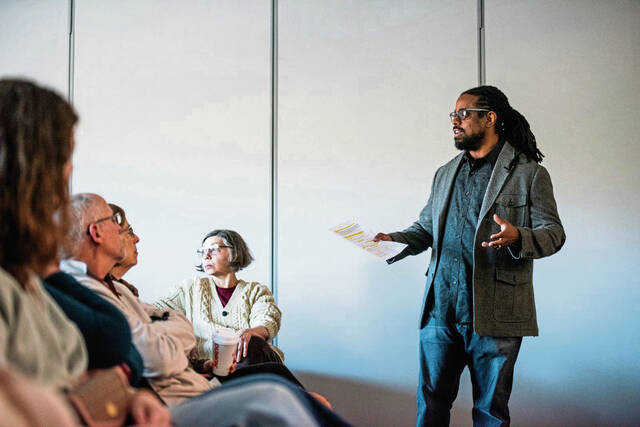Historical society marks 65th anniversary of Southern lunch-counter protests
Kelton Edmonds doesn’t just know the history of the “Greensboro Four,” the group of Black freshman students at North Carolina Architectural & Technical State College, who staged the first lunch-counter sit-in protest.
He got a firsthand account of it from Jibreel Khazan, who was known then as Ezell Blair Jr., about Feb. 1, 1960, when he sat down with three other Black students at the “whites-only” Woolworth’s lunch counter.
“He talked about his nerves as they walked down the street to do what they sought to do,” said Edmonds, a history professor at PennWest University.
Edmonds gave a talk Saturday at the Westmoreland History Education Center in Hempfield, on the 65th anniversary of the lunch-counter sit-in that ultimately sparked similar protests across the nation in advance of the Civil Rights Movement.
“His leg was shaking at the table,” Edmonds said. “There was the external pressure of, how will the police react? How bad might this get? Blair and (fellow protester) David Richmond were from Greensboro, so there was the added pressure of whether there would be repercussions for their families.”
Although waitresses refused to serve them, in accordance with the store’s segregationist policies, the four continued their protest. In the following days and weeks, they were joined by more students from other nearby colleges and high schools.
By April 1960, the protests that flooded the lunch counters of the segregated store spread to other cities throughout the South, involving more than 50,000 Black student activists and sympathizers.
As the protests began making it impossible for Woolworth’s to conduct regular business, the company desegregated its lunch counters during the summer of 1960.
“They didn’t expect it to take off the way that it did,” Edmonds said. “They wanted to change that local store. And because it happened to be Woolworth’s, a national chain, other students felt they could target that same store.”
The site of Saturday’s talk — where the 1775 Hannastown Resolves protesting the injustices of the British Parliament were drafted — wasn’t lost on some in attendance.
Marilyn McSparrin of Greensburg said she can see a through line from those 18th-century documents to modern times.
“You can see it from the Hannastown Resolve protest to the Vietnam War protests when I was in college, to what you see today.”
Edmonds said there’s a direct line from the 1960 sit-ins to modern times, when Black students have utilized peaceful protest to address similar issues.
In 2015, University of Missouri student Jonathan Butler went on a hunger strike, demanding that school officials address Black students’ concern with incidents of racial intimidation on the campus. It ultimately led to the resignation of the university’s president and chancellor.
“I see tactical correlations between all of that,” Edmonds said. “That protest grew to include a sit-in and the support of the Missouri football team. There’s a line that continues from 1960 well into the 21st century.”
Westmoreland County Historical Society member Jim Clayton of Greensburg said Edmonds’ presentation was very educational.
“It’s great to see something from someone else’s point of view,” he said.
“It’s easy to live in ‘the bubble,’ ” said Anne Kaylor of Greensburg. “A program like this not only exposes us to history, but it also speaks to things happening today.”
Edmonds cited his own university as a prime example. It was then called California University of Pennsylvania.
“Students approached the administration in 2003 and threatened to hold a protest because classes like African-American history weren’t being taught there,” he said. “The school brought visiting scholars in, and eventually they made those classes permanent.”
Patrick Varine is a TribLive reporter covering Delmont, Export and Murrysville. He is a Western Pennsylvania native and joined the Trib in 2010 after working as a reporter and editor with the former Dover Post Co. in Delaware. He can be reached at pvarine@triblive.com.
Remove the ads from your TribLIVE reading experience but still support the journalists who create the content with TribLIVE Ad-Free.


